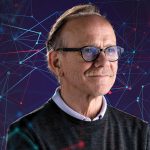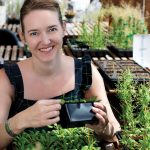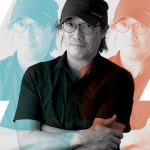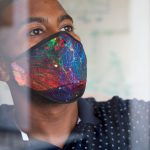INSIGHTS Gerald Pao Pushing the limits in science and in life
From studying the novel coronavirus to downloading brains to computers, Staff Scientist Gerald Pao is at the forefront of scientific advancement. For Pao, being a staff scientist gives him the freedom to explore a broad range of risky scientific endeavors that could yield pioneering results.
“A staff scientist can be an incredibly enabling position, where I can pursue a greater variety of topics that are difficult to approach in more traditional positions—and I have a lot of interests!” says Pao.
Path to Salk
Pao grew up in Spain, Germany and the United States. He had a keen interest in science from an early age, and when he was in middle school, he asked his biology teacher to teach him about gene expression and the genetic code. The teacher refused, telling Pao that he was too young, so Pao begged his father to help him find a mentor in molecular biology.
His father obliged, and at the age of 12, Pao began spending time at the Center for Molecular Biology at the Universidad Autónoma de Madrid, where he learned about gene expression in the model system Drosophila melanogaster, a fly. A few years later, at the urging of Professor Gines Morata, Pao decided to attend the University of California San Diego (UC San Diego) due to the strength of molecular biology programs both there and at the Salk Institute, across the street.
For his undergraduate degree in molecular biology, Pao explored the evolution of tyrosine kinases—enzymes that serve as on/off switches—and the complex nature of protein interactions. In his sophomore year, Pao connected with Salk Professor Tony Hunter, whose seminal discovery of tyrosine phosphorylation (the mechanism behind the on/off switches) led to the development of an entire class of anticancer drugs called tyrosine inhibitors, one of which is the leukemia drug Gleevec.
“Tony has an amazing, encyclopedic breadth of knowledge and excitement for science,” says Pao. “He is like the wise man on the mountain that you can consult about any scientific query.”
Pao completed his PhD in molecular biology jointly at UC San Diego and Salk, and he now works as a staff scientist in Hunter’s lab.
Day-to-Day
Prior to the COVID-19 pandemic, Pao spent many months of every year in Japan, taking skin samples from ocean-dwelling bigfin reef squid for his research. Squid have special proteins, called reflectins, that allow them to camouflage themselves by tuning the amount of light reflected by their skin—manipulating what scientists call the optical density. Pao is trying to hack these reflectins so that scientists can more easily view internal processes, such as the activity of the brain.
Although the pandemic has made his squid project more difficult to pursue, Pao has numerous other scientific endeavors to keep him busy, including his research involving the novel coronavirus.
COVID-19 Research
At Salk, Pao and colleagues have engineered a fake virus that has the exterior of the coronavirus, allowing them to study a mutation in the spike protein; the protein is what enables the virus to pull itself inside the host cell. “We’re interested in a mutation in the spike protein that makes the virus possibly more infectious,” says Pao. “When we introduced the mutated virus into human cells in the lab, we observed that the cells became infected five times more efficiently than with the nonmutated virus.” Although these findings are preliminary and were conducted using a virus that mimics the novel coronavirus, they could help guide vaccine design for specific coronavirus strains.
Pao is also working on creating fluorescent fake viruses that light up, which will allow scientists to determine whether viruses stick to surfaces, such as face masks, or how the viruses move in air-conditioning systems.
Leisure Time
In his free time, Pao likes to play volleyball and surf. He also enjoys rock climbing and has been known to sneak up to Yosemite for a weekend of big wall climbing on El Capitan.
Fun Facts
Pao paid for college by working as a professional model in Europe. He modeled in commercials for athletic brands and walked the runway for fashion brands, such as Benetton. Pao also speaks German, English, Mandarin, Cantonese and Spanish fluently.
Future Projects
Pao and colleagues are working on a new project that allows neural data from the brain to be downloaded to a computer. The researchers are taking the data from fly and fish brains and converting it into a computer model to create a program that behaves like a real fly or fish.
“Essentially, we are downloading a fly brain onto the computer,” explains Pao. “It’s not just science fiction. We want to create artificial intelligence that is based on real biology.”
Support a legacy where cures begin.
Featured Stories
 Leading Salk science into the futureInside Salk sat down with Rusty Gage to learn more about his background, approach to managing a world-renowned Institute, and vision for Salk science over the next decade.
Leading Salk science into the futureInside Salk sat down with Rusty Gage to learn more about his background, approach to managing a world-renowned Institute, and vision for Salk science over the next decade. Julie Law – Revealing RNAAssociate Professor Julie Law shares common themes underlying her research and discusses what motivates her both in and out of the lab.
Julie Law – Revealing RNAAssociate Professor Julie Law shares common themes underlying her research and discusses what motivates her both in and out of the lab.
 Gerald Pao – Pushing the limits in science and lifeFrom studying the novel coronavirus to downloading brains to computers, Staff Scientist Gerald Pao is at the forefront of scientific advancement.
Gerald Pao – Pushing the limits in science and lifeFrom studying the novel coronavirus to downloading brains to computers, Staff Scientist Gerald Pao is at the forefront of scientific advancement. Austin ColeyAustin Coley, though only at Salk since 2019, has already taken an active role in everything from conducting innovative research on the brain to spearheading a wide variety of outreach activities.
Austin ColeyAustin Coley, though only at Salk since 2019, has already taken an active role in everything from conducting innovative research on the brain to spearheading a wide variety of outreach activities. Salk’s Harnessing Plants Initiative (HPI) Garners Widespread SupportNew grants are supporting the Institute’s efforts to optimize plants’ natural ability to store carbon and mitigate climate change. This support bolsters the ongoing HPI project focused on model plants that was funded through donations to The Audacious Project in 2019.
Salk’s Harnessing Plants Initiative (HPI) Garners Widespread SupportNew grants are supporting the Institute’s efforts to optimize plants’ natural ability to store carbon and mitigate climate change. This support bolsters the ongoing HPI project focused on model plants that was funded through donations to The Audacious Project in 2019.



















































